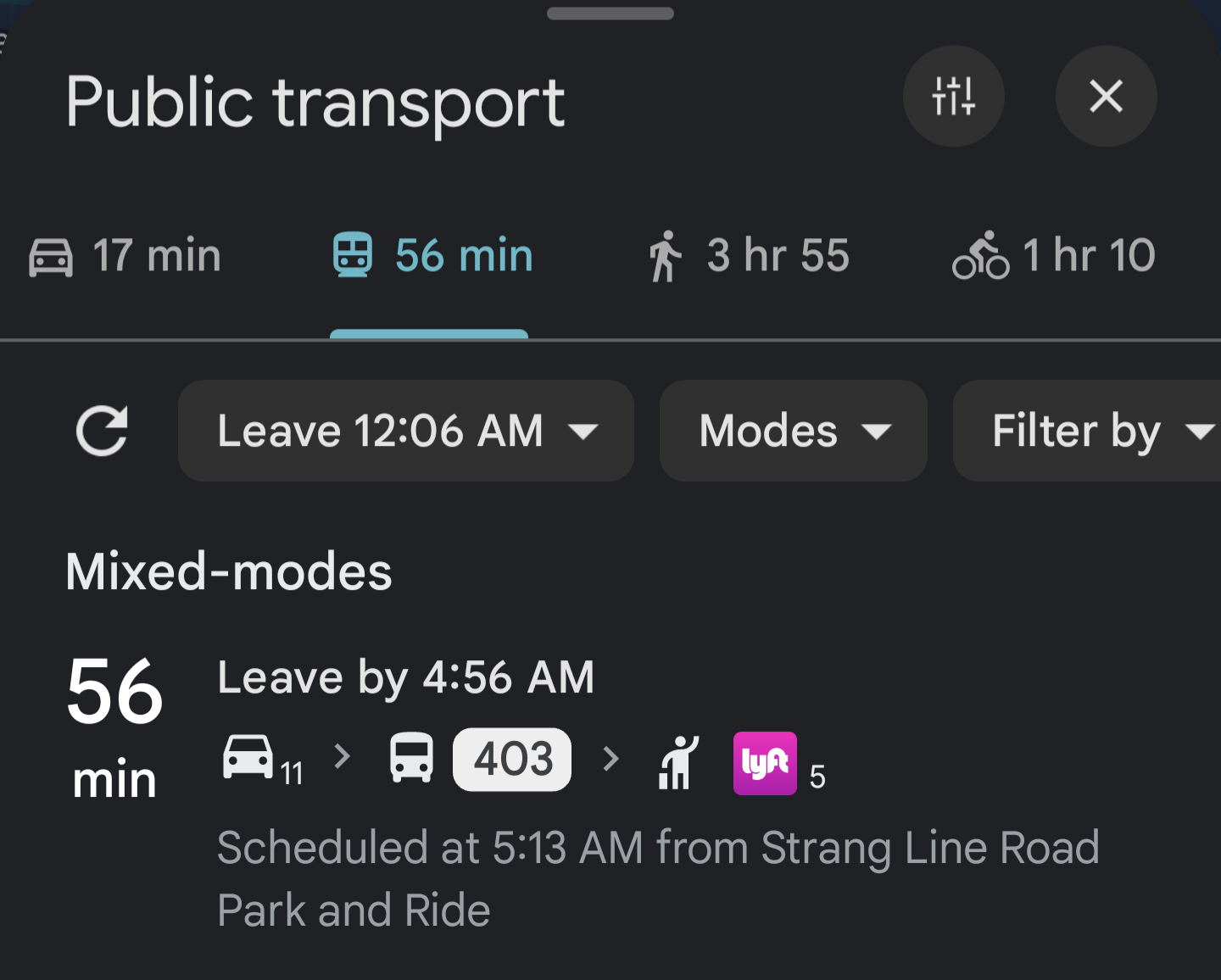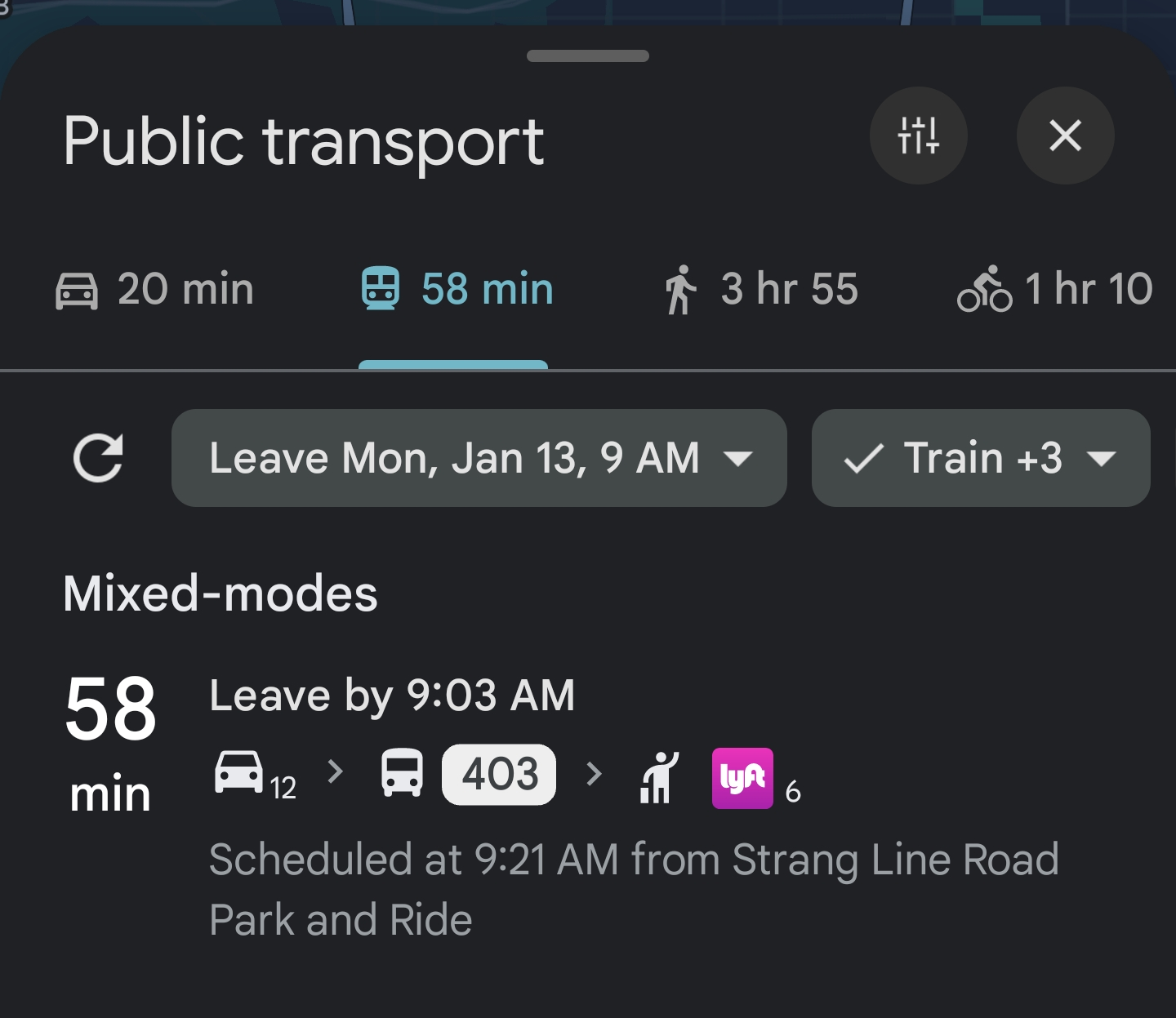Congestion pricing is such a good idea everywhere there is rock solid public transit alternatives. Where there’s not, it just becomes a tax on the poor.
Can you explain congestion pricing?
Think whole road tolls you can change based on a schedule, or based on current and expected traffic. All of it is meant to either disincentiveize driving to cut down total traffic, or at least shunt it to less congested times or roads.
Aside: I 1000% don’t consider individual toll lanes to be a type of congestion pricing. Those are just convenience surcharges (looking at you too TSA Pre check) and are complete elitist bullshit that hurts everyone but the city that takes in the fees.
Can you explain congestion pricing?
How about you explain how BigFish@'s comment is wrong instead. You clearly have a point to make, so do the work to make it.
I’m genuinely asking. Chill
OK, but in that case, usually you’d want to send that sort of request to google instead of looking for a lemmy thread of questionable veracity to educate you. I’d be careful what you ask for and to whom you ask, but you do you.
If I were rich, I would support congestion pricing. I could sell my helicopter. Who needs to fly over traffic when there is no traffic?
Yeah but all this $9 add up to millions which you can funnel into heated massage chairs on the trolley, tram, boat, bus or train. I want Netflix and free WiFi.
They will never funnel that money into more comfortable transit.
bicycles are good too, though maybe not for the longer distances that you would put congestion taxes on
Can be good. I ride my bike when I can, but my area IS NOT built for it, so it actually pretty risky. Heck some normal routes for me would probably get me stopped by the cops for recklessness.
I’ve biked a lot in my life, and I’m very aware of my surroundings, and I know when to stop riding and start walking the bike.
For some reason…most bikers are NOT like me. I don’t know why, they just aren’t. They’re dumb and clueless and, especially if they’re men in athletic spandex, really entitled and do really dangerous shit. They get on bikes with their car-brain still loaded, and make decisions like they have a shell of metal and crumple zones and airbags around them. Even though they’re just squishy flesh on a bunch of metal tubes.
Last summer, I was driving through a construction zone, and some 9-5 commuter guy on a bike decided to bike through the construction zone too, right along with all the cars. The road was narrow even just for cars, and the pavement had been ripped up and filled in as they did work to replace water mains underneath the road, and he was trying to bike through it, next to the cars. I was worried for him and kept looking in my rear view after I passed him. Good thing I did. Behind me, a truck pulling a small trailer clipped him accidentally (since the trailers swing back and forth a bit when navigating an uneven, narrow construction zone), and it clipped the front tire of his bike and he fell. It wasn’t even purposeful, the guy who clipped him stopped too to make sure he was ok. It was just a dangerous area to bike in. I got to the guy first, so I stopped and called an ambulance for him.
Overall he got away lightly. He was shaken and bruised and had a small gouge on one finger, and was able to refuse the ambulance and have a relative drive him to an urgent care. But when we looked at his helmet, it was cracked, and if he hadn’t been wearing a helmet even that light lovetap he got from the trailer might have been much worse. The helmet probably saved him from even more serious harm.
I didn’t say it to his face, because I figured he’d learned his lesson, but it was REALLY fucking stupid to try to ride a bicycle through a construction zone like that, helmet or no. He was just a dumb 9-5 commuter guy in a dress shirt and tie trying to save on gas or the environment or whatever–and I guess he just never thought about what he was doing beyond that. He had car-brain, and was trying to ride his bike as if he were still in a car through a zone where it was really dangerous to NOT be in a car.
It doesn’t matter if the laws say cars need to share the road with you or whatever–the laws of physics are much more concrete than the laws of mankind, and you need to pay attention to your physical surroundings and get off when you end up in a situation like that.
Anyway. My whole point is–yeah, some areas just aren’t safely bike-able.
If you can afford a car, you can afford an e-bike, even a cargo e-bike. Cars are luxuries compared to bicycles. Never forget that.
And if you are too poor to live near your employer?
I don’t know where you live, but that’s just not true in large swaths of America. The other options add multiple hours round trip anywhere and in many parts of the US it’s not an option.
My work is currently a 20 minute drive down a freeway going 60 mph. There is no bus to take that route. There isn’t even a connection, or a transfer, the only other option would be a cab.
I’m just talking basic economics. A car costs 10x what an e-bike does. A car is, by any logical definition of the word, a luxury purchase compared to an e-bike. You just live in an area where you’ve decided that everyone needs to get around in luxury vehicles, and you’ve built that into your infrastructure. This would be like building all of our infrastructure to only accommodate stretch limos, and then trying to argue that limos are a necessity. It’s comically absurd. It’s a clown world.
You just live in an area where you’ve decided that everyone needs to get around in luxury vehicles, and you’ve built that into your infrastructure.
I did not decide that. The cold hard reality is that my work and my home are 15 miles (24km) apart. That’s a 1.5 hour bike ride, 3 hours round trip. You are absolutely right about costs, but I have NO option to bus, I cannot bike that daily, none of my coworkers live next to me.
I want more public transport. I would rather live with just a single car in my household that we use solely for large trips and moving large amounts of stuff. God knows it would be cheaper. I’d like that. I can’t feasibly do it.
How are you going to take an ebike for anything besides a short distance on non highway roads?
Not true.
I haven’t owned a car for most of my adult life, and things start to get really difficult in winter with snow (insufficient bus routes in a given area, and sidewalks/bike lanes covered in snow and not able to be transversed).
When job-hunting I had to exclude a lot of places because of how impossible it’d be to do the commute in winter. Given how expensive rent is, plenty of people are forced to live with relatives or live in certain cheaper areas long past when they’d prefer to leave, which means if the roof over your head is in an area without sidewalks/bike lanes/public transit, you rely hardcore on a car to get to work and back. And if you don’t have that car, you basically lose your job. Maybe you can sustain it over the summer, but once winter snow kicks in you’re pretty fucked the first hard snow or ice that comes through. If you’re lucky, it’s close enough to walk–but not everyone is lucky like that. Also, if your job has mandatory overtime and you’re doing 50-60 hour weeks, walking 2-3 hours one way to work is a no-go.
I say this as someone who regularly biked/used public transit in Chicago winters. Not having a car shaped my life in ways that effectively made me poorer/deeper in poverty.
Not having a car shaped my life in ways that effectively made me poorer/deeper in poverty.
Another way to say this is that designing an entire landscape around the car has shaped everybody’s lives in ways that make millions of people poorer/deeper in poverty.
I’m talking the machines themselves. A car costs 10x what an e-bike does. Yes, infrastructure sucks in many places. That doesn’t change the fact that a car is objectively a luxury compared to a bicycle. You live in an area that has made getting around in a luxury vehicle the only practical option. That doesn’t mean cars aren’t luxury vehicles. People who live in areas that mandate that the all homes must be at least 10,000 ft^2 don’t automatically become poor.
Cars are a luxury, while bicycles are utility. We just build our cities with classism in mind. We build our cities to require expensive luxury travel modes, all in some misguided attempt to keep the poors out.
Your definition of objectively is off. Just because there is an alternate universe where cars would be a luxury doesn’t mean that cars are a luxury for all timelines.
Status quo of now demands a car. It sucks. We are now stuck in a vicious cycle of people need cars because there’s no public transit -> people don’t need public transit because they have cars -> people need cars because there’s no public transit
@IonAddis needs a car. Without it, their job options are limited. Much like me. We’d like to ditch our cars, but we can’t.
Aw, c’mon, cars are objectively speaking luxury items today. A modernized Daihatsu Opti with a sticker price of about $5,500 (the inflation-adjusted price of a Ford Model T) would completely meet the requirements for getting and keeping a job.
Sure would, where can you buy those?
I have the same question. I can’t. Cars are all luxury items nowadays.
Maybe if you live somewhere it doesn’t snow
For over a decade I went everywhere by bike in Sweden. They have bike lanes that get plowed and sanded in winter, the snow is not a problem, the problem is places with bad, car-centric infrastructure.
Congrats for having a good immune system. I was sick once a month the year I decided to bike to work in winter.
This is valid if your city doesn’t have dedicated bike infrastructure that gets plowed. Snow can be hardly an inconvenience at all if bike infrastructure is treated with equal importance as car infrastructure.
Oh the Urbanity! on Youtube has a really realistic take on this in Montreal: https://youtu.be/sokHu9bhpn8
Linking w/o tracker here
How does one avoid freezing their nuts off riding in the snow? I used to bike to school when I was a kid and even at less than a mile ride with gloves and shit on my hands and face were killing me by the time I got there.
So, caveat: I think the guys in thi sthread trying to put ideals of a no-car society over the reality of what it’s like to be poor and commuting every day on bike are full of shit. That said, I have spent most of 20 years biking to work in the vicinity of a big city.
In winter, you have to dress like you’re prepared to be lost outside overnight with no shelter. Like, you have to learn to ACTUALLY dress for the cold, for extended periods of time. (And you have to pay attention to the weather report–if it’s going to be wet, you need something that can handle being wet.) Most kids who try to bike to school try to do it in the clothing that they’d wear to drive to school. They either do not physically own the winter layers they need to stay warm, or they were never taught to properly layer.
But basically, you need probably 3 layers minimum in Chicago-type weather. Probably more if you’re further north. I would regularly wear jeans with two layers of some type of pants underneath, like fleece and some other base layer, and on top I’d have long-sleeve shirt, t-shirt, another long-sleeve shirt or sweatshirt or sweater, and over all of that a heavy duty winter jacket. For my head I’d have a full-face mask with a thick warm hat on top. Sometimes a scarf too. For my hands, I’d have multiple layers, and I’d usually wear mittens rather than gloves because mittens are warmer, and I’d have more than one pair of mittens. When biking, at least one layer of mittens needs to be wind-breakery because that wind is COLD. For shoes, I’d have wool socks, sometimes two pairs, and real heavy-duty winter boots on (not sneakers or whatever).
The thing is, a lot of people who never have had to actually spend significant time out doors won’t even OWN sufficient layers to stay truly warm in the cold. Either due to poverty (it costs money to buy really, truly warm clothes of the right material), or lack of knowledge of how to dress for the cold. (I lacked both when I was young!) Or they’ll have thin cotton fast fashion when they actually need wool or synthetic warm-weather gear. Or they’ll be concerned about looking stupid (because if you dress properly, you look dumpy and not cool.)
Great, and those places service maybe 10 percent of the United States.
This is about educating people so we can help fix this issues. No one is saying our system of car focused infrastructure isn’t there and fucked up. They’re saying car infrastructure costs significant amount of tax money (which you’re paying invisibly) and have a large cost associated with them. Bikes are relatively cheap, and their infrastructure is much cheaper, and the same is true for public transport.
Yeah, our society is dominated by car interests. Part of the problem is when anyone recommends a solution that isn’t cars people complain saying “this doesn’t work in this situation” and we never improve. Just agree it would be great and it sucks it isn’t better. You don’t have to always say it doesn’t work in a lot of places. We are all very aware.
Even in contries where there’s good public transport that’s not really the case. My aunt lives in a town 40min from where I live, and she wakes up at 4am to go work at a factory 10mins from where she lives. There’s no public transport at that hour and no, an ebike is not a viable solution for those roads.
I’m all in for having big parking spaces outside of cities so people load off their cars and then use public transport, but in the countryside that’s just not viable.
That sounds like an infrastructure problem. If you built roads that were only accessible by literal monster trucks, would you try to pretend that monster trucks are suddenly practical necessities instead of ridiculous extravagances? Your aunt just lives in an area where they decided that it’s OK to require people to make a big luxury purchase just in order to get around. It may be necessary to buy a big luxury in some areas, but that doesn’t mean cars suddenly become the transportation of the working class.
You have to have to be suffering from a severe case of motornormativity to believe the clown math that a $2k purchase is a luxury while a $40k purchase is a necessity.
This is not the US, there are no monster trucks. It’s just a place in Spain where several towns are near each other and the factory is in-between so people go by car. We live surrounded by mountains my dude, it’s not an infrastructure choice.
Motornormativity holy shit you really have not stepped a foot outside cities huh.
I don’t have a car but good fucking luck telling factory workers that their car is a luxury lmao.
I take it you’ve never been outside a big city in Texas, California, Colorado, Kansas, Montana, Wyoming, Minnesota, Arizona, Nevada, Oregon, Washington, Et Cetera.
I’m only listing places I’ve been. An e-bike would just not cut it, especially if you have small children. There are places you can not go without getting on a freeway, and there is NO WAY IN HELL I’m putting a small child on the freeway or highway on a bike.
Why are you talking about infrastructure? You’re changing the subject. Obviously the infrastructure needs to support them, just as cars are pretty damn useless without good road infrastructure. But cars are objectively an order of magnitude more complex and expensive than e-bikes. Cars are a luxury, bicycles are a utility. The key problem is that many cities are built to require you to use the luxury means of travel instead of the affordable utilitarian ones.
Naw, we are talking about the same thing. I bring up infrastructure, as many have, because that’s the reality of the situation. The entire continental United States is built for cars, and that’s not changing anytime soon. The reality is that cars are necessary, and at this time, it is near impossible and a safety hazard for most americans to try and use bikes due to the hostile road infrastructure in place.
It is NOT economically more feasible here, at this time, and unless the investors that have put billions of dollars into lobbying for car-dependent cities suddenly want to default on their near-hundred year investment, it isn’t going to happen.
A car can be used to move an entire family safely. You need 3-5 bikes to do the same far less safely including the very young, old, infirm.
Fatality rate for sedans is 2 per billion vehicle miles. Bikes are about 110.
Bear in mind that this is in the US which has bad drivers driving aggressively in environs ill suited.
Furthermore the average person commuting by car commutes 30 minutes by car the average bus rider an hour.
These are often distances too great to bike.
If you are moving a full car of people, it’s probably the best way to get around. However the average occupancy of a car is 1.2 people. The vast majority of cars have just 1 person, often driving less than 5 miles which is an easy distance to cycle.
Having more people cycling means the roads are less congested for the people who really need to use them. And with less people driving and more cycling, it should hopefully get safer.
People need the car for the average commute which is more than five miles its about half an hour by car which means half of commuters drive longer. Having already expended substantial resources on the car the cost of a 5 mile jaunt is about $1 to 1.50 round trip and 10 minutes or 30-45 minutes including waiting and 3-5 for the bus.
Alternatively if the wealter is neither very cold hot or rainy and you have an extra hour and don’t mind arriving sweaty and rumpled you could bike and risk your life more than driving a 1950s car!
Its an impractical idea that doesn’t scale compared to telecommuting and improving public transit.
The danger comes from cars, and the reason the distances are so great is because the landscape was designed for cars. Those fatality numbers are biased to make it seem like bicycles are dangerous by framing it in terms of the mode of transportation the victim was using, instead of the agent causing the fatality, and by comparing the numbers to VMT.
But, spin it differently: Capitalist elites
bribedlobbied politicians to force you to spend your money and time on a motor vehicle to schlep your family around like sacks of potatoes to all your destinations by locating them unreasonably far away, so that the huge amounts of space needed by motor vehicles fit in between, and they could enrich themselves by selling motor vehicles. Now it’s become an arms race of bigger and bigger motor vehicles, further lining the pockets of the capitalist elites, at the expense of people’s (especially children’s, the disabled’s, and elderly’s) agency and freedom—because otherwise they’ll die under the bumpers of the maniacs operating motor vehicles that you’ll encounter in all of those extra miles you’re forced to travel.Different spin, different bias, but still 100% fact.
VMT is the only reasonable metric to compare relative safety. It is literally the only metric that tells you how safe your family will be traveling.
The fact that its cars that mostly make bikes dangerous is important but mostly irrelevant to any individual making decisions.
Same with America being spread out. Mostly it is because it was cheaper and therefore more profitablr for individual actors not some grand conspiracy.
The elderly, young kids, and especially the disabled don’t need safer bike lanes they need better public transit
I strongly disagree with VMT as the proper measure, and here’s a simple, constructed example of why:
There are two cities of about 200,000 people. One is compact, and easy to get around by transit, walking, or biking. The people drive around 2,000 miles per year each. The other is a low-density, mostly suburban area, and people drive around 15,000 miles per year. They have the same casualty rate per VMT of 3 per million miles.
Those two cities aren’t equally as safe. Not even close! The one city would have 1,200 crashes, injuries, or deaths each year, and the other would have 9,000. That’s a major difference which should be accounted for in policymaking and land-use decisions.
As far as the American landscape, it’s spread out not because it was cheaper. How could that be, when it takes more infrastructure to spread out? It was more expensive, and that was actually the point of car-dependent suburbs. They were more expensive to build and maintain, which kept the undesirable people out. Then, the desirable people were subsidized, through the GI Bill, tax breaks, mortgage lending standards (e.g. redlining), and the like.
I don’t claim it’s a grand conspiracy, but it is verifiable history.
The metric you desire ought properly to be determined by what problem you are trying to address. We aren’t building America like sim city we are deciding what to do with our existing situation. For a person deciding what to do they need to weigh the actual consequences of various choices. Deaths per billion not million vehicle miles captures the actual costs of doing so. 2 for sedans 110 for bikes.
Anyone who drives 15,000 miles isn’t replacing their car with a bike. You would be asking them to bike 288 miles per week which is absolutely insane. Nobody is doing this. If they drive 5000 they might but at the cost of a drastic increase in risk. This leaves us where we are now where almost everyone either can’t or won’t.
This is great, should be implemented in all cities. Most people who can use public transport should.
Not all cities are equal. Many have large areas with no public transportation available.
That’s also very easily fixable
I get suggested to drive for 11 minutes and ALSO take a lyft if I wanted to use public transportation to get to work.

Do you always go to work in the middle of the night on a Sunday?
That’s just when I browse Lemmy 🥲
So, what you posted is not really meaningful and representative of your daily commute, right?
I’m so confused about what’s wrong, the bus stop doesn’t suddenly get closer if I leave at 9am monday…?

Doesn’t seem to apply to your specific case but usually there’s a big difference between middle of the night vs. during the day. Even though I live in a city with a good public transit infrastructure, if I try to get to my workplace at three in the Morning on a Sunday I will still have a bad time:

vs.

That’s why your first screenshot didn’t really prove much.
In SF they allocated some extra carpool lanes (taken from the total number of highway lanes) and started calling them “express lanes” instead of carpool lanes. Everybody cheered-- because transit hipstering is a great thing for the people who it actually works well for in our mediocre system. I guess everytone else is SOL. In SF it started out that you could still use them for free if you had 2 people in the car. Now its 3 people minimum to ride free, and the prices crept higher. Now you’ll very often see all non-express lanes stopped with traffic but the price for express lanes high and the express lanes clear of traffic-- that road throughput capacity underused. Its become a rich persons lane, at the cost of reducing capacity of the total system. When it got put in they said the max would be $8.00, shortly after they doubled that, with no max per day. Fees rack up since they charge over short distances. Now I’ve started seeing express lanes on main thoroughfares that arent highways.
Theres a patchwork of diconnected and not well thought out transit systems, with little hope of retrenching them to have usable coverage like NYC has. You’ll end up using an uber or taxi to get to your final destination most of the time, and parking at transit stations is difficult, time consuming, and expensive.
This is not the solution you think it is. It just makes things better for the rich, and does nothing for the poor and middle class. This is like the “clear” lane at the airport security. Once its in, its not going away. Pricing is not in the control of people who have your best interests at heart. If you’re poor, your time is not worth as much as a rich persons. They are commoditizing the hours of your life and many of you cheer for it. Without progressive pricing for this you’re just getting fleeced.
The funds created arent going toward new projects . They are used for road maintenance, enforcement, and debt repayment in the county where the road is This simply frees up general funds that had been used for that before these went in, so no direct benefit in terms of transit projects is mandated.
As someone who takes public transit into SF every work day. It exists. It works. It’s faster than driving
It works.
It works for you in your current situation. But this policy affects people who are not in your exact situation as well, and it DOESNT work for them. I know you want to do something, anything, but we need it to be more than this.
we need it to be more than this
That goes without saying?
As I understand it, poor and middle class people are already taking public transit. It’s the rich people who are driving in New York. This is making it easier for deliveries, taxis, buses, and emergency vehicles to get through by getting all of the entitled rich people off the road.
You think charging them 20 a day will get the rich off the road?
Looks like it is! (See above)
Also, those lanes were open to everyone for 2 months before they had everything online. There was absolutely no traffic those months. Once they turned on the scam lanes, traffic was back with a vengeance… Unless you paid.
That is expected. When a lane is added it fixes traffic for some time then it goes back to the same due to induced demand. Look at Texas and their 26 lane highway, it has not fixed their traffic problems and never will. It is always hard to move towards less car dependence, but it will never happen if we keep adding lanes.
Fixing traffic by… discouraging people from driving, lol. Well I’m not complaining.
Outstanding move on NYC’s part.
Prior to this going live there was a lot of talk about how congestion will simply move from one place to another. I don’t know new york so can’t name places but it was regarding commuters using a street or bridge that is now under congestion charge so they will flow an alternative route through roads that aren’t designed for the additional traffic.
Is that now the case?
Some people may be inclined to go up and over Central Park to get to the other side without paying the $9. That likely only affects uptown residents. I can’t imagine anyone driving around the park from midtown to avoid the fee.
The only legitimate concerns I’ve read are from contractors with tools and small businesses who deliver. They should be offered exceptions if walking or mass transit are unrealistic options. You’re not riding the subway with acetylene tanks or delivering fresh meat on Metro North. Other than that, I love it.
sure, but you can also deliver those with lighter vehicles that don’t cause traffic. Congestion is congestion.
I’m confused. How will I deliver 15 pounds of Trump skirt Steaks if I can’t drive my lifted Ram 3500 Heavy Duty with the high-output Cummins Turbo Diesel engine in downtown Manhattan?
They should be offered exceptions if walking or mass transit are unrealistic options.
No they shouldn’t. That’s how you let rich people skirt the law.
Tradespeople should just treat it like any other business expense. Eat it or raise your rates a little bit.
eat it
They never do
a little bit
It’s never a little, and we all bitch about inflation.
There’s never a simple solution.
They sometimes do, at least temporarily. But yes on the whole I agree. I can almost guarantee that it’s a net benefit, that the time saved by traffic reduction makes up for the additional cost in congestion charges
Construction firms make a ton of money in NYC, they can handle it, and I don’t think I’ve ever seen someone delivering food from a car in the city, they all use bikes.
The other concern I’ve heard, and has not been brought up in this thread yet, is the lobbying influence from rideshare companies to pass the congestion laws.
It’s arguable that ride share vehicles are a better traffic density alternative to single rider personal vehicles, but there are pretty clear downsides to consider as well.
Source:
You can be self interested and still accidentally be on the right side of an issue. It doesn’t spark joy, but I’m not going to throw the baby out with the bathwater on this. It’s still a win, imo.
Of all the things on Reddit, I miss remindmebot the most. They tried to kill it numerous times but it survived like a roach in radiation. On lemmy, I find an interesting question and have to set a timer for myself. This is the most first-world of problems, but I’m still moderately upset every time
@remindme@mstdn.social 10 days
@bdonvr Here is your reminder!
@bdonvr Ok, I will remind you on Monday Jan 20, 2025 at 12:08 PM PST.
@remindme@mstdn.social 10 minutes
@Gullible Ok, I will remind you on Friday Jan 10, 2025 at 1:05 PM PST.
It lives!
inb4 the supreme court rules that congestion charging is unconstitutional and furthermore that public transport, too, is unconstitutional.
If the founding fathers didn’t explicitly mention it in the Constitution then clearly it’s unconstitutional.
Pooping is unconstitutional.
But removing the separation between chruch and state is, any part of the constitution (ex: Article six, the first amendment, the fourteenth amendment, and multiple supereme court rulings on the constitution) are clearly just liberal lies
Congestion pricing bad, private tolls good
I REALLY wish they’d implement that in my home city of Montréal, Québec. We’re facing huge traffic congestion because of construction. It’s so bad it’s actually costing lives due to driver impatience.
Downtown Toronto too, please. This last year was the first time I have seen multiple emergency vehicles not being able to get to their destinations because of traffic gridlock. It’s insane.
Sam from Wendover did a very good job explaining why Congestion Pricing is the best solution to address this particular problem, including arguments on why this is not a regressive tax when you analyze it closely.
Canonical YouTube link so you can use your favorite Invidious/Piped instance https://youtu.be/B2j-LgcA7Gk
And same on nebula: https://nebula.tv/videos/wendover-the-battle-over-nyc-congestion-pricing/
Does anyone have a good before screenshot of the same map view / area? I want to stitch together a before shot before I share so that people not from the area can get an idea of the change and not just immediately think “oh well my small town has traffic and it looks like that so what’s the big deal”
not exactly but with Google Maps you can setup a route with a start time set in the past and look at the congestion at that moment:

Lmfao, that’s the same distance as my commute to work, and I can bike that in 17-20 minutes
Yeah, but you can’t bike through the tunnels
Why not?
As long as that money is spent on public transit improvements, I think it’s a great idea for many large cities.
Sorry best we can do is 80% to the police department.
is spent on pubic transit
Hahahahahaha
Oh sorry, I thought you were joking. Of course they won’t
is there any particular reason you’re saying that besides cynicism? I am having trouble finding specifics, but there’s a lot of reporting that the MTA is expecting to raise $15 billion from congestion tolling to fund public transportation repairs and improvements and pretty much all of the proposals for this in the past required all of the revenues to be earmarked for use by the MTA
People are so used to how bad things are they don’t trust improvement, even when it’s real.
don’t trust improvement
*By a corrupt government which has proven itself to mismanage funds as a default.
Can’t really speak to NYC local but time will tell. Although to give them credit, most NYers I’ve met enjoy their public transportation. But the admonishment of general government expenditure distrust is completely valid imo
NYC as an institution has many hard-working people at all levels dedicated to their communities.
The mayor, however, is a worthless self-serving piece of shit that sold out to foreign nationals, and a good chunk of the city elite are corrupt one way or another.
It’s a very, very mixed bag.
Are we sure that it’s causing people to take alternative transit more vs just… Not going to Manhattan though? I’m all for it, just worth studying more.
Either way, the policy is working as intended; there are fewer superfluous car trips being made to lower manhattan. If people are deciding not to go over a $9 fee, I don’t think they really needed to go that badly.
That’s incredibly short sighted. How long before companies realize that they aren’t paying employees enough to live in NYC or deal with the congestion tax and the company has no choice but to leave NYC altogether? Then tax revenue declines and the city is short on the budget!
If you understand that the congestion tax (and lets face it, it’s a tax) goes up in years 3 and 5, you’ll realize that this isn’t going to get better. I commute to work in NYC every day and drive my personal vehicle probably once a month. It was never cost effective to drive into NYC. Someone who’s already paying $850 for parking, $300 for bridge tolls and the cost of their car is not worried about the extra $9/day.
Oh and BTW, the first day of the congestion tax was a snowstorm so no one was driving in anyhow!
Nice. Now cars are only for the rich like they should be.
Real solution: Ban cars in parts of NYC.
The poorer you are the less you can afford paying for it. This is really just a method of opening the streets just for the rich.
Regressive solution.
Cars in Manhattan were already “just for the rich”.
It’s simply making the rich think for a moment, before taking their car to the street. Which makes the streets safer for everyone who’s not rich.$9 doesn’t make any rich person think twice.
Can anybody tell me how much a drive through the congestion priced road would cost? Like a straight line?
$9 for cars, no matter if you go one block in or all the way through. And no daily charge for staying there multiple days, only charged when you enter.
Kinda unfair tbh
See the Congestion Pricing Tracker for day by day measurements of the impact on congestion.
I’m trying to see the big improvement but it looks like there’s only a few minutes at best difference in drive time going on. What don’t I understand?
Wait time is getting slashed across the board. An example: If in rush hour traffic, 8 minutes was added, but now it’s 3 minutes, that’s five minutes of car fumes and CO2 avoided, of more cars moving about, of goods being transferred. We’re not shaving seconds, we’re shaving literal minutes!
We’re talking about hundreds of thousands of vehicles. This is New York with millions of people. People, businesses, all these things are affected. If you combine this with other data, you might better see the outcomes.
This isn’t tiny incremental gains. From a economic/environmental/commerce standpoint, these are multipliers.
I mean you’re just making efficient transportation something that wealthy people can just buy…
Private vehicles aren’t efficient, they’re convenient.
Your comment presumes that everyone has access to public transit that suits their needs. Many people do not.
Which would be the case if there was no caveats for people with low incomes and those with mobility concerns… however, there are discounts and even full on exemptions from the congestion pricing.
https://new.mta.info/tolls/congestion-relief-zone/discounts-exemptions
All those green lines aren’t supposed to be an example of efficient transportation? Is that not exactly what the author is trying to convey?
No, those coloured lines are just the traffic indicators on Google maps, green just means “traffic flowing normally”, red is “traffic jam”
You said “no” but everything after that said “yes”.
Traffic flow is efficient. Cars are (very often) not
Thank you
Regressive tax. Yet another kick in the face of the lower class. Why not a progressive tax based on personal income? It works pretty well for speeding tickets in northern Europe.
I’m all for reducing traffic, but yeah, how is this not at least partially regressive? Folks who can only afford to live in New Jersey but then have to work in NYC now have yet another new expense.
But maybe I’m not aware of just how ubiquitous subway stations are in New Jersey that go into NYC. Would it be an easy transition?
It’s my understanding that poor people in NYC already take public transit. It’s just the rich people who drive.
Besides, less traffic in NYC probably means cheaper parking, so people who have to drive will probably see their cost unchanged.
That’s not quite true https://www.cssny.org/news/entry/congestion-pricing-outer-borough-new-yorkers-poverty-data-analysis
There is a small percentage that are poor and will suffer more due to being out priced out of transit areas
That’s unfortunate. But does it balance out the better quality of living the poorer people who live in the city are going to have? Can it be mitigated by expanded bus lines?
I really don’t know. My gut says that this is still a net positive for equity, but don’t trust that guy, he’s an idiot.
We can’t hold every type of tax-incentive based progress hostage because our culture won’t tolerate day-fines or other income-scaled penalties. I mean we could, but it wouldn’t make sense. This is a good program and it has an option for low income people to pay less. Furthermore we can always funnel money from rich to poor in other ways (e.g. through unrelated).
and it has an option for low income people to pay less.
You’ve never been poor have you. Its an extra 300 bucks taken away for no benefit, assuming they qualify for the low income benefit, and its 400 fliushed down the tubes if they dont.
Maybe if you are that poor don’t pilot your personal vehicle into the congested parts of Manhattan, where you pay for parking on top of the general costs of your car such as insurance and fuel.
Take the subway like me and a million others.
Remind me your grand plan to institute day fines again?
Maybe if you are that poor don’t pilot your personal vehicle
And there it is. That privilege. “if you’re that poor”.
Remind me your grand plan to institute day fines again?
Progressive tax on a scarce resource based on income. Complete exemptions for disabled. Better rates for working poor than 25% off.


















